Category: Umeå Institute of Design
PhD 90% Seminar
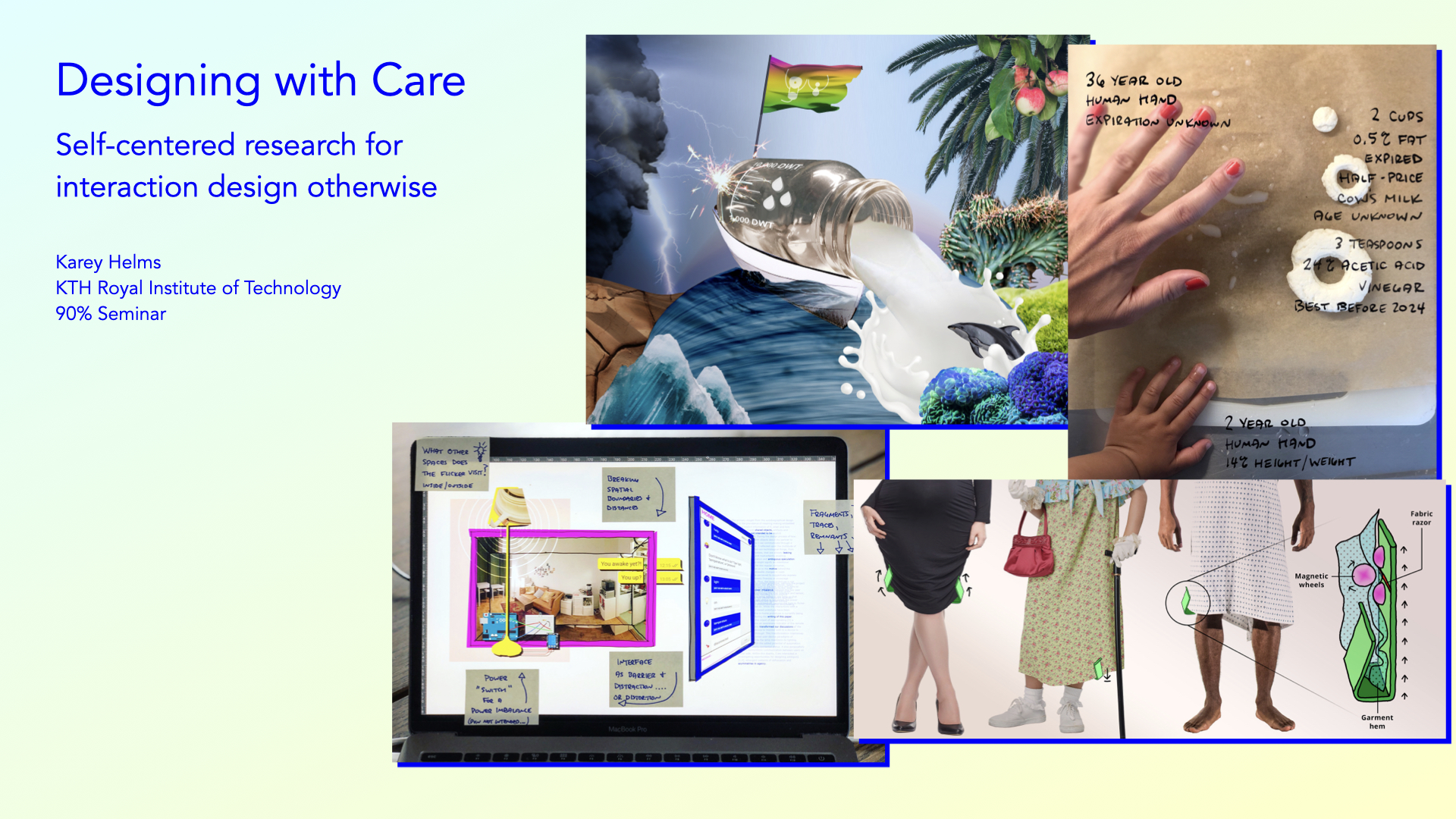
This week I had my 90% (“final”) seminar with Heather Wiltse from Umeå Institute of Design. I’m very appreciative of her engagement with my work and difficult questions that energized me for my next few months of writing. The tentative title and abstract of my thesis below:
Designing with care: Self-centered research for interaction design otherwise
This dissertation is about the research program designing with care as a pathway towards interaction design otherwise amid a world in crisis. Considering how established ways of doing interaction design will change involves recognizing the role of digital materials in social injustice and systemic inequality. These concerns are inseparable from the material complexity of interactive experiences and their entanglements in care. Through five design experiments, I explore wickedly attending to human everyday care, and an intimate and generous questioning of oneself.
I offer four contributions for interaction designers and design researchers. The main contribution is designing with care. Within this programmatic framework, I contribute extended articulations of wickedness and generosity. The third contribution is the synthesis of four methodological approaches: auto- design, spatial orientations, leaky materials, and open speculations. Each is a generative and analytical pathway towards five careful designs as prototypes of what interaction design otherwise might be like: technologies of human waste, spying on loved ones, leaky breastfeeding bodies, scaling bodily fluids, and a speculative ethics. From these, I discuss disciplinary resistances and personal struggles to reflect upon implicating oneself within more-than-human care, and consider the benefits and limitations of designing with care in moving beyond self-centered research towards more sustainable worlds.
UID Wednesday Lecture 2018 – Crafting Humorous Fictions & Taboo Frictions
Yesterday I had the pleasure of spending the day at Umeå Institute of Design (where I did my MFA in Interaction Design). In the morning I spent a couple hours with upcoming IxD master thesis students to discuss my experience, and in the afternoon gave a talk titled “Crafting Humorous Fictions & Taboo Frictions” as part of the design school’s Wednesday lecture serious. Was great to be back, even if only for a day! Below is the abstract of my talk.
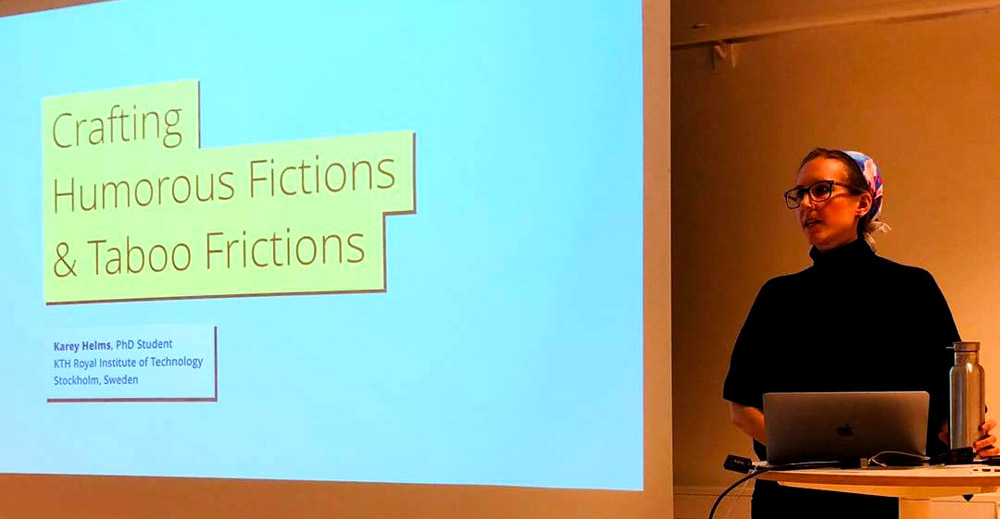
Talk abstract
Karey Helms is a PhD Student at KTH Royal Institute of Technology researching smart implicit interactions, those that are unseen or unnoticed yet proactively operate on our behalf. Her research through design approach includes speculative and autobiographical methods in which she designs humorous fictions and taboo frictions with intimate and somatic data to surface the social and societal implications of data-driven systems. These include the designing of fictional devices that predict when and how badly one has to urinate, and the prototyping of a genuine system to spy on her partner.
In this talk, she traces back her playful approach to fiction and friction to her master’s thesis in Interaction Design at UID and how she employed this approach while working in industry delivering actualized services within enterprise IoT prior to beginning her PhD. The aim of this talk is to advocate for humor in design and to craft experiences that disrupt and disturb to not only provoke others to think, but also yourself as a designer.
NordiCHI 2018 – Presentation & Slides
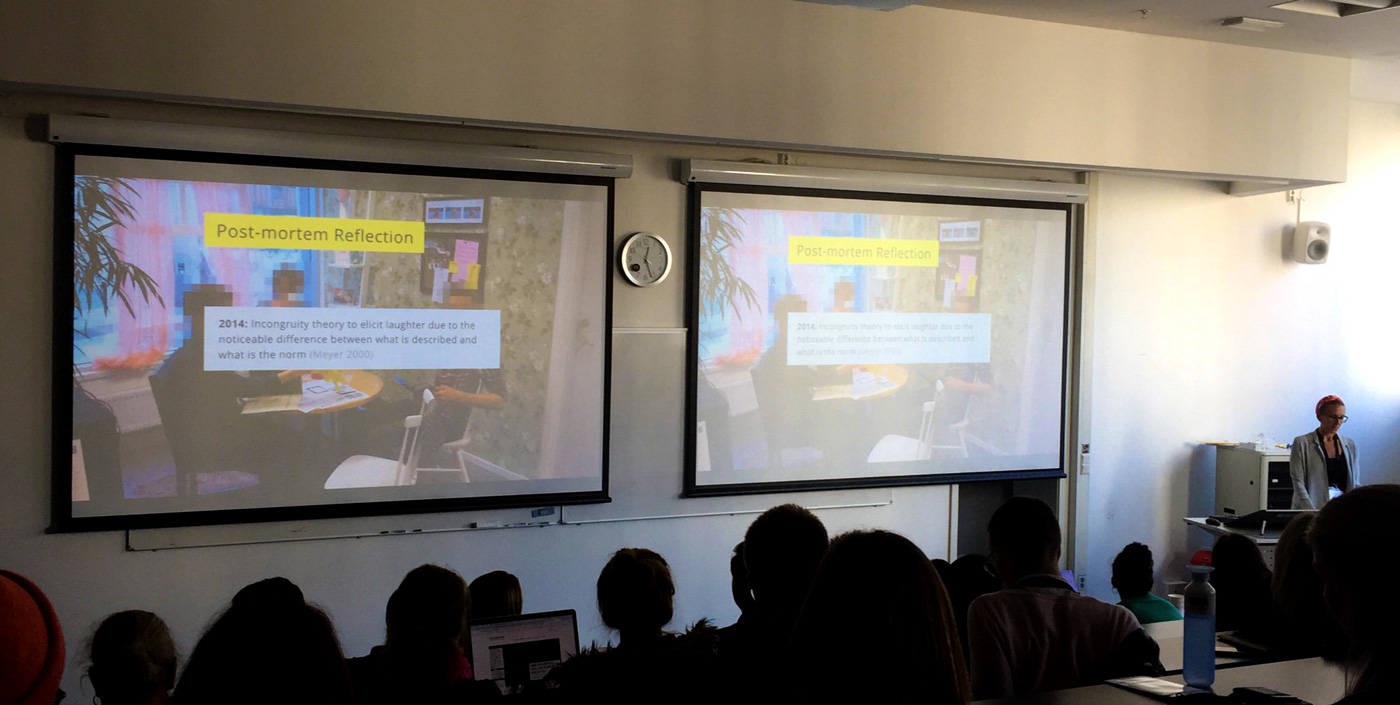
Early this week I presented a paper written with my PhD supervisor Ylva Fernaeus on the use of Humor in Design Fiction to Suspend Disbelief and Belief at NordiCHI 2018 in Oslo. This paper was part of the future scenarios track at NordiCHI, an excellent initiative and venue that explores the design of design fictions. Our paper contributed (1) a way in which humor might be used in design fiction (and design more broadly), (2) a design process that includes fieldwork to inform the design of design fictions, (3) and a human-scale design fiction as a method of communication and dissemination. For the presentation, I originally intended to role-play the paper presentation as a character from the fictional world, as I did when presenting the same project four years ago in Umeå as my master’s thesis, but last minute opted to not because of the opening introductions by moderators. Instead, I opened the presentation by jumping into the fiction with no context, and then gradually introduced more information and built reflections throughout the remaining of the presentation. I think this structure worked very well. The full paper is available here and the presentation below.
NordiCHI 2018 – Accepted Paper (Future Scenarios)
Very excited to have a NordiCHI 2018 paper accepted in the future scenarios track! Written with Ylva Fernaues, my supervisor at KTH, the paper is about why and how I used humor in my MFA thesis at Umeå Institute of Design four years ago.
Karey Helms, Ylva Fernaeus. 2018. Humor in Design Fiction to Suspend Disbelief and Belief. ACM Nordic Conference on Human-Computer Interaction (NordiCHI 2018), Oslo, Norway.
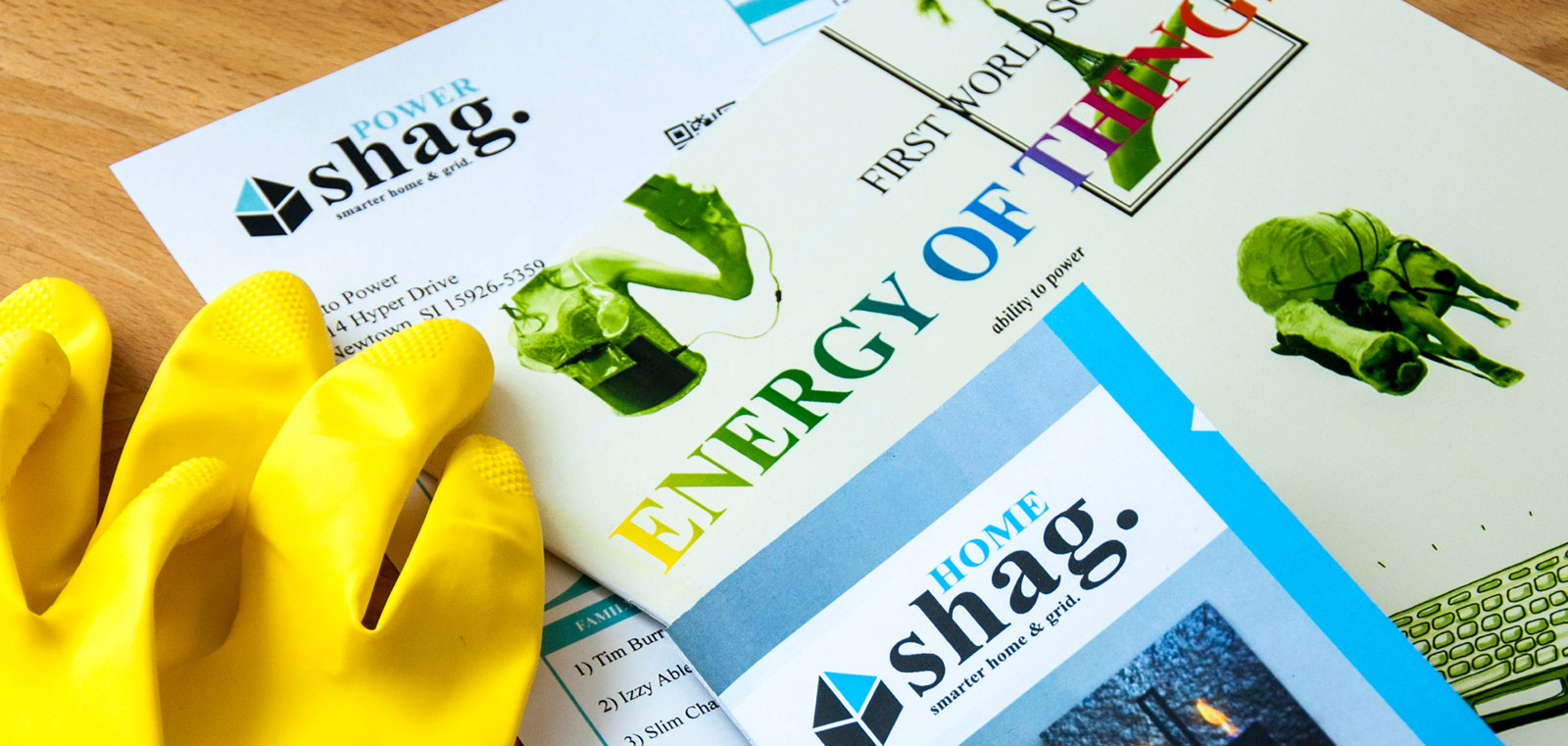
Humor in Design Fiction to Suspend Disbelief and Belief
This paper investigates humor as a resource and strategy for design with discourse as an intended outcome. While humor can incite empathy and understanding, it can also lead to alienation and disengagement. Through the detailing of the pre-narrative and narrative processes of an exemplar design fiction we describe why and how elements of humor, in particular puns, parody, and pastiche, were employed. Following the presentation of the fiction and its use in the design of an exhibition and diegetic prototypes, the paper presents responses from participants and audience members to reflect upon how humor was received within the design fiction. Following these reflections, as the near-future scenario was written four years prior to this paper and is now situated within present-day, it then concludes with a post-mortem reflection on the floating nature of humor.
MFA Thesis – UID Exhibition at Semcon
I was selected to exhibited and present my Interaction Design thesis project, The Family Circuit: A New Narrative of American Domesticity, with a group of other UID graduates for three days at Semcon in Göteborg, Sweden.

MFA Thesis – The Family Circuit report
First draft of my MFA thesis report has been ordered from blurb. PDF version available to download here.
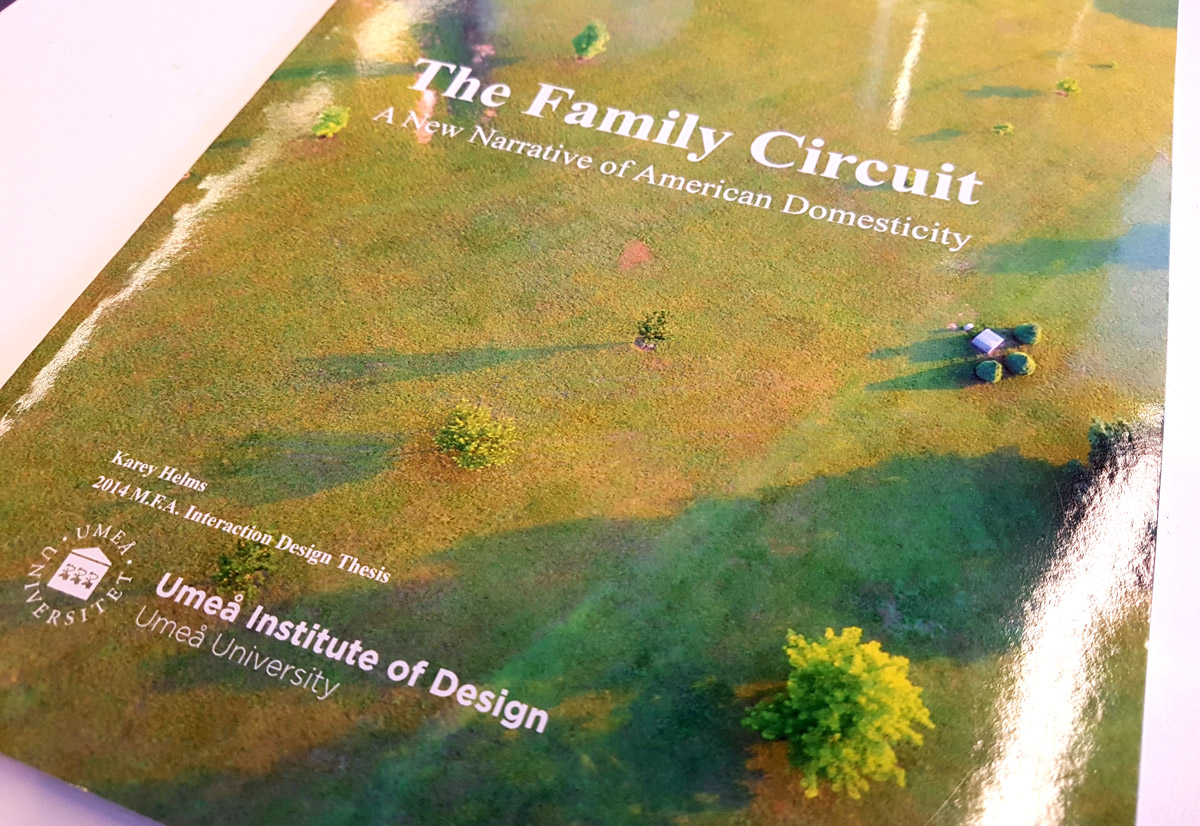
Thesis Narrative: Final Plot & Radio Show Script

Plot
Lotta Power wants her home to be ranked highly on the energy produciton list in the weekly shag. Home brochure. When she doesn’t see the Power family listed as a top net energy producer in Newtown, she becomes irritated. The brochure highlights the energy harvesting potential of the piezoelectric shag Carpet Footprint already installed in the Power family’s central home energy system. In order to stimulate more energy production while also inhibiting consumption, she hides Max’s headphones so he cannot work on his ambient DJ album. Frustrated, as she anticipated, Max begins searching frantically, running around the house and thus generating electricity as his feet rub and pounded on the shag carpet. Though, in his fervent searching, he causes a ruckus and wakes sleeping Minnie frightfully from her nap. As Minnie begins to cry profusely, she no longer sucks on the energy harvesting Pacify Her that Robin personally uses to charge her smartphone. Right as Minnie drops the Pacify Her, Robin receives a text notification about a new submission to Suburban Dictionary, the website she founded and manages, but doesn’t have time to read it before her phone dies. As Minnie is still crying and refuses the Pacify Her, Robin begins to suck on it herself. Otto wishes to watch the morning news before heading to work, but sees the television is low on power and Lotta has disconnected it from the central home energy system. As he observes Robin awkwardly with the Pacify Her, he luckily has just enough power in his phone to seize the opportunity to take a photo and post it to Instagram. Just as Robin’s phone turns back on, charged by the pacifier, she sees the image Instagram and becomes furious. Since she doesn’t want to loose power in her phone and thus continues sucking on the pacifier and expresses her anger through violent gestures. Luckily, she is wearing the Temper Trap purchased by Otto, which harvests energy from vigorous movement and skaking. As she intensely expresses her emotions over the photo, Otto is able to wirelessly charge the TV with energy harvested from the Temper Trap. Overheated from emotion, Robin turns on the air conditioning, which is part of the central home energy production system, draining the house of all recently produced energy. The Power family is no powerless.
Thesis Gateway Presentation Feedback
Following my gateway presentation last Friday, I received a lot of helpful feedback regarding my next steps and exhibition priorities and setup. During my presentation I skipped all previous background and process material and essentially launched into a narrative of the fictional world and characters I’ve created – you can read the first draft iteration of The Family Circuit: A New Narrative in American Domesticity.
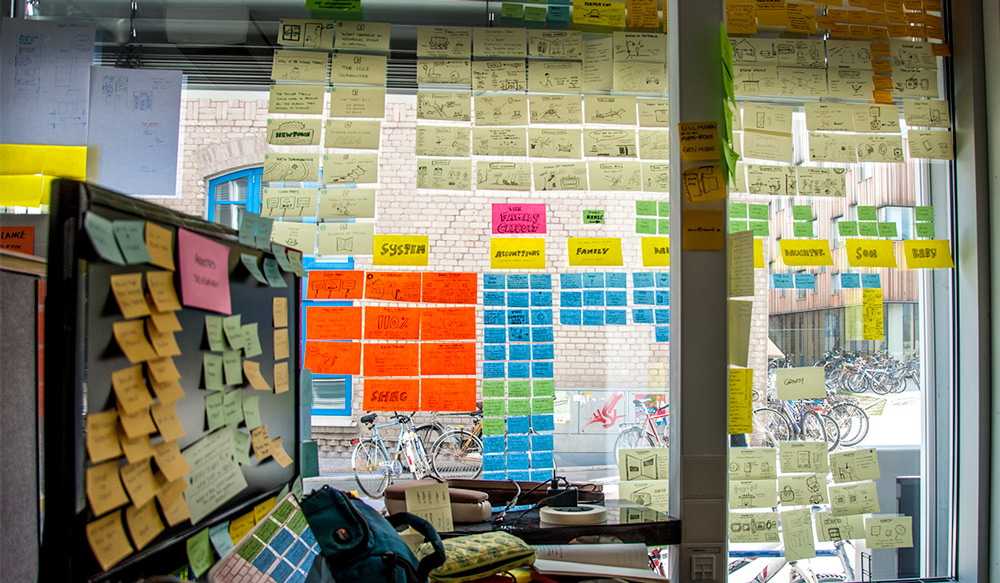
Feedback from reviewers included:
- Finding a balance between conveying main message quickly vs requiring in depth analysis. Is the goal to get the message quickly? Essentially, my exhibition needs to be able to cater to those with a short attention span, while also allowing the various layers of the project and story to reveal over more time and with additional material. I personally am more inclined to cater to the latter, as I feel making the message overly explicit will sacrifice the experience of peeling back the layers.
- Emphasis on storytelling: be sure to connect and relate the characteristics of the characters into and through the cycles of daily events (something I have but need to work on making more explicit and central).
- 5 minute presentation at design talks could be a a narrative describing the world and omitting the why/how I got here. Of course, followed by an ‘if you want to see more, check out my exhibition…’
- Make the exhibition minimal, highlighting the artifacts. Hint at other aspects of family life, but don’t overload with unnecessary details.
- START STAGING NOW. Make a mini mockup of the exhibition plan, which could also inform if I want to make it full scale (most likely) or something along the lines of a cornell box.
- Various supplementary ideas: Pulp fiction book, digital photo frame, Whole Earth Catalog (love love!), mockumentary (Modern Family & The Office – REALLY which I had time for this, but unsure)
- Make my infomercial idea a higher priority
- Make objects in photos/GIFs/video pop in relation to Energy of Things catalog
- Match the exhibition setting to the scenes used in supplementary material
- Don’t forget to relate and check back to my original intention: energy consumption awareness
My own thoughts & reflections:
- Lots to do!
- Keep having fun!
The Family Circuit: A New Narrative of American Domesticity
Last Friday was IxD thesis gateway presentations – more so a private discussion with tutors and reviewers to assess our thesis progress, plans, and priorities for the upcoming five weeks. As my thesis is taking a strong design fiction direction, I did not give a presentation, yet read my draft narrative. To be completed this week, but please enjoy the preview below… it’s proudly quite ‘punny’ (wink wink).

The Family Circuit: A New Narrative of American Domesticity
It was a cloudy morning in early May, as were most days in Newtown. Otto Power approached the front door to check the weather, only to encounter resistance. Annoyed at the door’s conduct (tivity), he countered the friction with force, and it hesitantly opened – subtly challenging his potential motive while also directly insinuating the impending consequence. Going outside before breakfast was a break in Otto’s usual morning routine, especially for a weekday, and the mental energy used by the intelligent door to evaluate the uncommon situation would cost him the required electricity for a warm cup of coffee. Otto already speculated as much, for it was rare to have a morning electrical surplus. But he had woken with a vague yet irrepressible weight growing in his body, for Otto Power was tired. And so the forthcoming electricity sacrifice failed to impede the growing hope of a different day, and as he stepped outside he thoughtfully wondered aloud, “Will it be windy today?”
Family Circuit – Project Name & Inspiration
FINALLY got around to naming my thesis project due to some much needed pressure as all graduating students were asked to submit a selection of project information for the UID’14 Design Talks upcoming webpage. After a serious brainstorm yesterday morning, I came up with ‘Family Circuit,’ a subtle play and similarity to ‘Family Circus’ as recent developments in my project have brought forward the the family dynamics, individual characters, daily energy rituals, and cohesive storyline as a central focus of both my ideation and final deliverables. Which, on that note, also brings to light that though prioritized highly in my original goals, I’ve come to the realization that working energy harvesting prototypes are not essential to communicate my concept, and thus will take a back seat if explored at all. On the fun side, I’ve very much enjoyed this week researching and watching films featuring dysfunctional families – Wes Anderson perhaps being most influential. Great Wes Anderson Montage below by Alejandro Prullansky:
Though, its quite hard to top my favorite film family of all time – the Hoover family from Little Miss Sunshine.

Thesis Mid Review Feedback
I am very pleased with last week’s thesis mid review presentation and feedback. While I typically don’t look forward to ‘the making of’ – presentation process days – I’ve found these frequent thesis presentations useful both personally to more strongly formulate the best way of delivering my work, as well as extremely fruitful for the class to reconnect regarding each others projects. Not to mention, its exciting and rewarding to formally see your own progress. You can also view/read my full mid review presentation.

Feedback from reviewers included:
- One unified story in the end, perhaps focusing on a specific daily cycle within a single day of the year
- Videos as a potential result or strong support material
- Return to earlier ideas and re-brainstorm around them
- Potential organization of scenarios around maintenance (ex: father must take something to work to continue generating)
- Provoking question: What will be my everyday life?
- Either integrate or be able to answer why I’m not – the smart home and financial connections
- Look into Albert Borgmann’s Device Paradigm
- Potential inspiration in Fabrica’s Holidays in Iceland campaign
My own thoughts & reflections:
- While a lot of my current ideas are quite bold in their shocking nature and associated humor, I do not necessarily envision them as my end result and want to be carefully mindful choosing and crafting my final situations based on the strength of the content, not the statement. Though I love a big bang, I am fully open to a more subtle provocation if it entails a cohesive storyline and logical system.
- Furthermore, though a principle component of my earlier goals was the development of working prototypes, I’m beginning to see that this is really not necessary to accurately convey my concept and therefore not a worthwhile use of my time. Ah, killing a darling, I do love prototyping. Though, as one of my tutors expressed, I have plenty of working prototypes in my portfolio.
- Call me crazy, but I really love doing a thesis. As my undergrad did not involve one, I was naively unaware how much selfish satisfaction can result from intense investigations into your own passions. And its spring in Umeå.
Thesis Mid Review Presentation
This past Thursday and Friday were IxD2 thesis mid review presentations. Below are my presentation slides and annotations. Text written some odd place in between formal snippets taken from my report and my quite colloquial style of presenting. All background photos are my own unless stated otherwise.

Because every presentation should begin with a different quote!
Research Presentation
Last Friday we had our thesis research presentations, which was both a great opportunity for us individually to analyze and consolidate our findings, as well as get back up to speed on the status of others in the class. Below is an example slide from my presentation, displaying my established design principles resulting from research.

I found my post presentation feedback helpful in regards to exposing gaps in my research, holes in my presentation (information that is clear in my working report document but otherwise not explained verbally), and helping me plan next steps. Below are some feedback highlights:
- Give critical design background in presentation
- Be explicit about focus on indirect or direct electricity use
- Define scope of project also on what I don’t want to do
- Decide on a specific context
- Recommended read: Objects of Desire
As I have tentatively decided on a domestic context to stage my energy production/consumption scenarios, my primary next step will be to host an ideation workshop next week. In addition, I will be spending a lot of time in the upcoming days updating my written in progress report and be researching prototyping materials as I need to place an order sooner rather than later.
Download my research presentation slides.
For further curiosity, you can also read my initial brief.
Daily Energy Interactions
A main component of my thesis research is the understanding of the existing mechanisms within the individual’s current relationship with energy. With an initial focus on basic interactions with electricity, over the course of a week I self documented three 24 hour periods with cellphone photographs. As my project deals with the direct individual experience of energy, I tried to both document and analyze based on a phenomenological perspective with Don Ihde’s four human-technology relations in mind. In addition to self studies, I also asked friends and family members outside of school to document their interactions with energy, photographing the physical interaction, environment, and furthest trace of electricity. An overwhelming fourteen people participated!

For further curiosity, you can also read my initial brief.
Energy Comics
Thesis humor. Hehehehe….


Initial Research Reflections
Last week commenced the research phase of degree work. Below are my thoughts regarding a small selection of articles, podcasts, and other miscellaneous inspiration.
Carl DiSalvo & Adversarial Design

Though he visited Umeå last year, I was embarrassingly relatively unfamiliar with Carl DiSalvo’s work and research until last week’s UID Wednesday lecture. Following a talk by Jamer Hunt, who again gave his inspiring scalar framework lecture that I repeatedly enjoy, DiSalvo discussed his concept of Adversarial Design, an alternative approach to Design for Democracy within Critical Design. Based on the democratic model of agonistic pluralism, which emphasizes the positive affects of political contestation, Adversarial Design uses design to reveal conditions of power while creating a space for productive conflict. DiSalvo asserts that many Design for Democracy projects are governed by the democratic principle of consensus, avoiding to acknowledge the necessity of discord. I particularly found beneficial his explanation of the difference between ‘designing for politics’ and ‘political design’ – rooted in the distinction between politics and political – the means by which a social order is held together versus a condition of contest within society. From his paper Design, Democracy and Agonistic Pluralism, DiSalvo states, “design for politics strives to provide solutions to given problems within given contexts, political design strives to articulate the elements that are constitutive of social conditions.”
A few key strategy points from his paper:
- Identify new themes
- Reveal conditions of power
- Create a space of conflict
- Identify new trajectories for action
As the primary aim of my degree project is to critique society’s relationship with energy, not make the consequences of Global Warming more accessible, I found DiSalvo’s lecture especially relevant. I additionally appreciated his presentation of Usman Haque’s Natural Fuse in which he highlighted the
- importance of a designed system to allow participation,
- playful and experiential engagement of resistance,
- overload of meaning in common objects that become a challenge,
- avoidance on a single ethical stance,
- and leaving open the resolution of contest.
Furthermore, in the followup discussion with both Hunt and DiSalvo, they discussed a specific tactic within Adversarial Design I aspire to assume – identifying collectives of various scales, and binding them strategically through a series of exclusions. While I haven’t yet formally defined how this will be accomplished in my future speculative scenarios, I believe it will be a useful and important method for both linking daily activities with personal technology and creating a larger relational network. Lastly, I also intend to adapt Hunt’s advice of beginning with an exploded diagram, mapping out my problem and design opportunities, formally placing where I believe I can intervene.
Discovery: Geo-engineering by BBC World Service

As I last week delved further into a more comprehensive understanding of Global Warming, the resulting climate change, and the three primary strategies against – climate engineering, adaptation, and mitigation – I listened to a podcast on geo-engineering. Discovery: Geo-engineering specifically focused on the release of sulphur dioxide in the atmosphere to reflect incoming sunlight. While I have always viewed this particular technique as rather radical, I appreciated the discussion regarding the unintended consequences, and therefore potential slippery slope, as well as the unavoidable termination effect. The former I could have assumed, but find something compelling with the general concept of the slippery slope argument that I feel could be integrated into my potential scenarios. In regards to the latter, after moving past my disturbance over the realization that if employed, once geo-eningeering is discontinued, the earth’s climate soon resumes its prior state; I see an interesting temporal conflict between a solution for now versus the future, overlaid with an enormous commitment to a finite procedure. Additionally, geo-engineering ironically seems to be most successful in its unintentionally role of inspiring people to use less fossil fuels – a radical proposal with serious intentions turned into critical design project. In conclusion, research into geo-engineering only furthers my commitment to focus on mitigation as an idealized outcome of my thesis – for “mitigation deals with the root causes of climate change.”
Freakonomics: Fear Thy Nature

Though more for entertainment than in relation to thesis, I really enjoyed Fear They Nature by Freakonomics. The episode is about the effects of external circumstances on human behavior, particularly focusing on the theater show Sleep No More and the famous 1971 Stanford Prison Experiment. While intensely focusing on a long term project, such as a thesis, its easy to draw parallels within almost anything, I definitely identified both personally and as a designer to the quote, “On putting people into total new situations, thats how we discover something new about ourselves.” I think the podcast’s discussion on control and context in connection to new situations can be applicable to critical design. Plus its an interesting listen.
Thesis!
After turning in our briefs this past Friday, thesis officially began on Monday, followed by five minute presentations from all UID degree students to the school yesterday (Tuesday). Below is the introduction of my degree project and brief.
For further curiosity, you can also read my full brief.

“To most Americans, the risks and consequences of energy consumption are vague and distant”
– BURN: An Energy Journal, Exploring for Oil and Gas in the Arctic
Scientists in the Environmental Protection Agency’s 2013 annual report on U.S. greenhouse gas emissions attribute the changing composition of the earth’s climate to human activities. The burning of fossil fuels, deforestation, and other sources are high contributors to these concentrations of greenhouse gases in our atmosphere (EPA, 2013). Research on American public attitudes and opinions towards climate change showed a majority view climate change as real, human action as the problem, and personal energy conservation as part of the solution (Gardner & Stern, 2008). Yet a 2010 study indicates that people have relatively little knowledge and understanding concerning the energy consumption and comparative use of familiar activities (Attari, Dekay, Davidson, & Bruine, 2010). Therefore, as many predict our current rate of global consumption will lead to the exhaustion of fossil fuels by the end of the 21st century, who will contribute and how, to a reduction of fossil fuel use accompanied by participation in sustainable future energy solutions?
My degree project aims to critique and challenge society’s relationship with energy by provoking individuals to examine their current habits of energy consumption, consider the future implications of these actions, and question their willingness to make sacrifices for a cleaner environment. This will be accomplished through the development of a fictional context in which individuals are required to produce all electrical energy that they need or desire to consume. Within this constructed situation, I will explore a series of potential scenarios that pair daily activities and their corresponding energy expenditures with the electrical consumption of personal devices or domestic technology. For example, an electric coffee maker must be powered by the energy generated from the arm motion used in brushing teeth. These explorations will include the physical prototyping of speculative energy harvesting solutions and an investigation of the personal, social, and temporal consequences.
What if you were required to produce all energy you desire to consume?
Split Flap
Last week we completed a 2 week individual ‘multi-layering’ graphic design course in conjunction with BeGreen Umeå and their Sustainable Ålidhem project. The brief asked us design multi-layered graphics that visualize the current sustainability status of Ålidhem (a residential neighborhood in Umeå). In addition, we were given a bus stop adjacent to the area as our site, in which the graphics were to be displayed with the goal of encouraging people to reflect and ask – How are we doing?, What can I do?, and Who can I talk to? – in regards to sustainability.
The purpose of the course was to ‘experiment with new and unorthodox ways of information graphics design in a specific context,’ which I used as an opportunity to take advantage of the ‘experiment’ aspect and instead proposed an analog installation that utilizes split-flap (or Solari boards) to facilitate sustainability awareness through an immediate feedback display of abstract information.
Long story short (as with the Sound Bowl post – more information later given when I update my portfolio), I spent the majority last week building a working prototype of a single split-flap, that would hypothetically be arrayed along the back side of the bus stop. The installation would display both practical (ex: the arrival of purple and yellow line buses) and conceptual (ex: board goes berserk when a non-sustainable ‘disturbance’ – a car – passes by) information through the graphical movement of colors. Not sure that makes sense without supporting graphics and animation. Anyhow, I’m pretty pumped about my prototype as I ran into lots of problems during the 4 day design and construction process, yet managed to complete it ‘at the eleventh hour.’
Skip to the last video to see the prototype fully working. As always, please ignore late night jargon.
Split Flap – Process 3 from Karey Helms on Vimeo.
Split Flap – Process 4 from Karey Helms on Vimeo.

